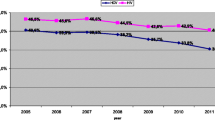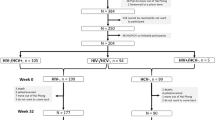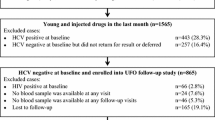Abstract
We examined three waves of National HIV Behavioral Surveillance surveys of persons who inject drugs (PWID) in San Francisco to assess meeting UNAIDS 90–90–90 targets. Diagnosis of PWID living with HIV increased from 64.4% in 2009 to 80.5% in 2015. Antiretroviral treatment among those diagnosed did not improve (63.8% in 2009, 62.9% in 2015). Programs in San Francisco have not achieved the first two UNAIDS targets for PWID by 2015. In a context of a rising opioid epidemic, there is urgent need for increased case finding of PWID living with HIV who are undiagnosed with rapid linkage to treatment.
Resumen
Examinamos encuestas de comportamiento en personas que se inyectan drogas en San Francisco para evaluar el cumplimiento de los objetivos de ONUSIDA 90-90-90. El diagnóstico en personas que viven con VIH aumentó de 64.4% en 2009 a 80.5% en 2015. El tratamiento antirretroviral no mejoró (63.8% en 2009, 62.9% en 2015). Los programas no han alcanzado los objetivos de ONUSIDA para personas que se inyectan drogas. En un contexto de aumento de la epidemia de opiáceos, existe una necesidad de un mayor esfueurzo de encontrar casos de VIH que no han sido diagnosticados con un vínculo rápido con el tratamiento.

Similar content being viewed by others
References
90-90-90: an ambitious treatment target to help end the AIDS epidemic. Joint United Nations Programme on HIV/AIDS (UNAIDS). http://www.unaids.org/sites/default/files/media_asset/90-90-90_en.pdf (2014). Accessed 3 May 2018.
Fast-track: ending the AIDS epidemic by 2030. The Joint United Nations Programme on HIV/AIDS (UNAIDS). http://www.unaids.org/sites/default/files/media_asset/JC2686_WAD2014report_en.pdf (2014). Accessed 3 May 2018.
Levi J, Raymond A, Pozniak A, Vernazza P, Kohler P, Hill A. Can the UNAIDS 90-90-90 target be achieved? A systematic analysis of national HIV treatment cascades. BMJ Global Health. 2016;1(2):e000010.
Keen P, Gray R, Telfer B, Guy R, Schmidt H, Whittaker B, et al. The 2016 HIV diagnosis and care cascade in New South Wales, Australia: meeting the UNAIDS 90-90-90 targets. J Int AIDS Soc. 2018;21(4):e25109.
Okeke N, McFarland W, Raymond H. Closing the gap? The HIV continuum in care for African-American men who have sex with men, San Francisco, 2004–2014. AIDS Behav. 2016;21(6):1741–4.
HIV Epidemiology Annual Report. San Francisco: San Francisco Department of Public Health. https://www.sfdph.org/dph/files/reports/RptsHIVAIDS/AnnualReport2015-20160831.pdf (2016). Accessed 3 May 2018.
Hladik W, Benech I, Bateganya M, Hakim A. The utility of population-based surveys to describe the continuum of HIV services for key and general populations. Int J STD AIDS. 2015;27(1):5–12.
Lansky A, Abdul-Quader A, Cribbin M, Hall T, Finlayson T, Garfein R, et al. Developing an HIV behavioral surveillance system for injecting drug users: The National HIV Behavioral Surveillance System. Public Health Rep. 2007;122(1):48–55.
Heckathorn D. Respondent-driven sampling: a new approach to the study of hidden populations. Soc Probl. 1997;44(2):174–99.
Hard-to-Reach Population Methods Research Group. Wiki.stat.ucla.edu. http://wiki.stat.ucla.edu/hpmrg/index.php/Main_Page (2018). Accessed 3 May 2018.
Raymond H, Scheer S, Santos G, McFarland W. Examining progress toward the UNAIDS 90-90-90 framework among men who have sex with men, San Francisco, 2014. AIDS Care. 2016;28(9):1177–80.
Rudd R, Seth P, David F, Scholl L. Increases in drug and opioid-involved overdose deaths—United States, 2010–2015. Morb Mortal Wkly Rep. 2016;65(5051):1445–52.
Funding
This study was funded by the Centers for Disease Control and Prevention (grant number 5U1BPS003247).
Author information
Authors and Affiliations
Corresponding author
Ethics declarations
Conflict of interest
All authors declare that they have no conflict of interest.
Ethical Approval
All procedures performed in studies involving human participants were in accordance with the ethical standards of the institutional and/or national research committee and with the 1964 Helsinki declaration and its later amendments or comparable ethical standards.
Informed Consent
Informed consent was obtained from all individual participants included in the study.
Rights and permissions
About this article
Cite this article
Kim, N., Welty, S., Reza, T. et al. Undiagnosed and Untreated HIV Infection Among Persons Who Inject Drugs: Results of Three National HIV Behavioral Surveillance Surveys, San Francisco, 2009–2015. AIDS Behav 23, 1586–1589 (2019). https://doi.org/10.1007/s10461-018-2284-1
Published:
Issue Date:
DOI: https://doi.org/10.1007/s10461-018-2284-1




